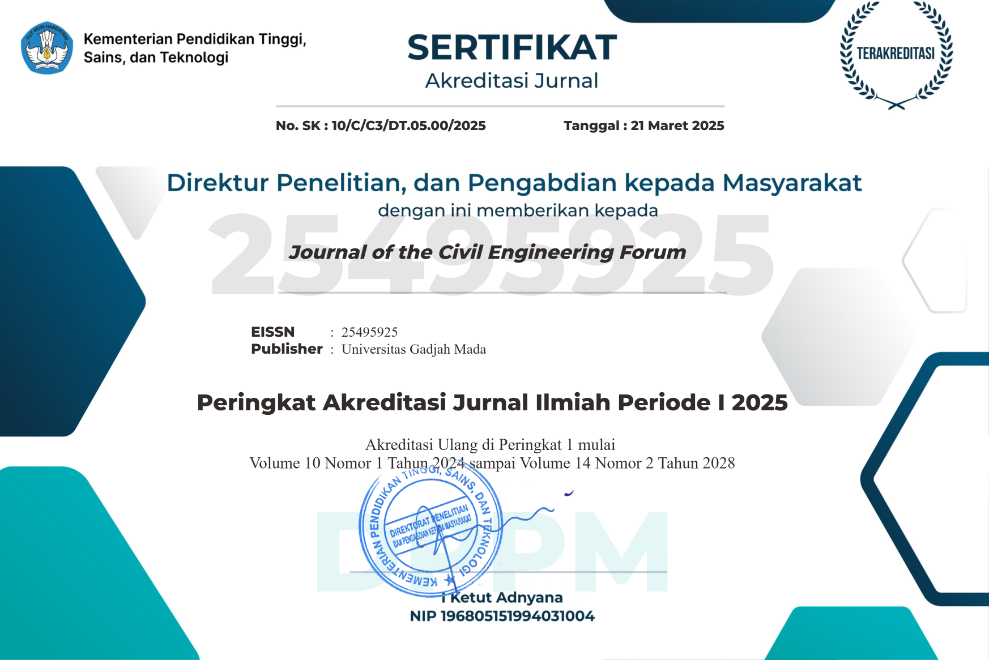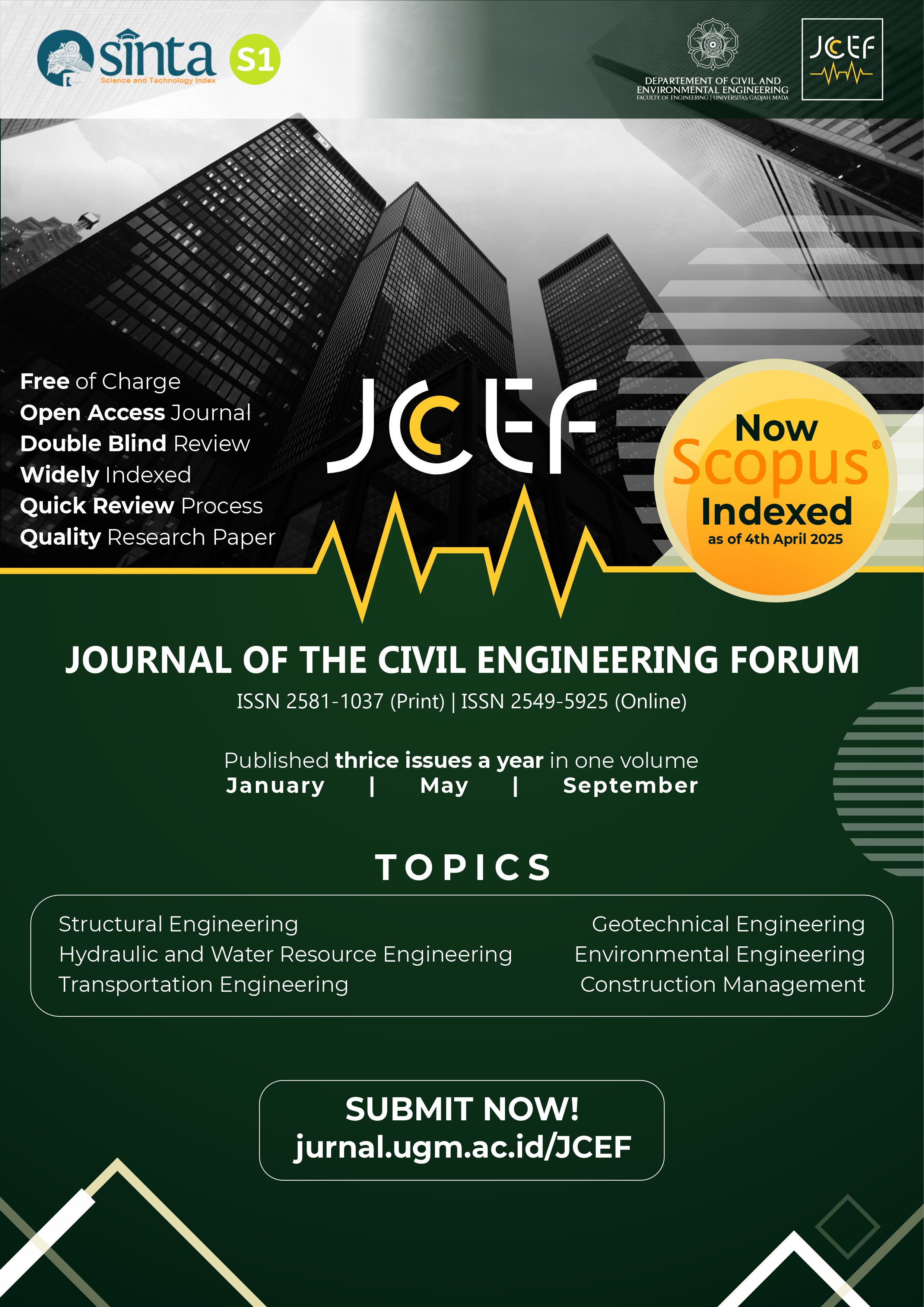The Influence of Temperature Variations on Rigid Pavement Concrete Slabs
Abstract
This research aims to assess the effect of temperature gradient developed within the concrete slab of rigid pavement, and to investigate its impact when incorporated with the traffic load, and the heat transfer pattern. The rigid pavement model considers an isotropic, uniform, and linear-elastic schemes to simulate the material properties. A numerical analysis approach was employed using Abaqus software incorporated with the 3D Solid model. The traffic loads were obtained from the field surveys, while the temperature of the slabs was measured directly on the site. The dimension of the rigid panel is 2.75 m in width, 5 m long, slab thickness of 25 cm, and concrete specification of 41.33 MPa. The results showed that the temperature gradient produced a significant impact on stress development within the concrete slab of rigid pavement. It was observed that the temperature gradient during the daytime generated higher stress than at night, with a value reaching the MOR (Modulus of Rupture). The exposure of the rigid pavement to 500C tends to produce a principle slab stress of 2.395 MPa, while 1.31 MPa was developed due to the traffic load. When the two factors were combined, the concrete slab acquired a maximum principle stress of 3.322 MPa, which is close to the MOR of 83.34% fa. These results showed that the pavement is capable of withstanding stress from temperature gradient and traffic load as indicated by the ratio of less than one (1). However, this ratio is high for fatigue failure mitigation purposes, and this reduces the quality of life of the rigid pavement.
References
ACI 302.1R-15 (2015) ACI 302.1R-15. Guide to Concrete Floor and Slab Construction Reported by ACI Committee 302.
Aulia, G. (2015) Evaluasi Penggunaan Controlled Modulus Columns ( CMC ) Di Bandara Soekarno-Hatta. Yogyakarta: FT UGM.
Bowless, J.E. (1997) Foundation Analysis and Design. 5th Edition. 5th edn. United States of America: The McGraw-Hill.
Cui, C. et al. (2022) ‘Analysis of the Coupling Effect of Thermal and Traffic Loads on Cement Concrete Pavement with Voids Repaired with Polymer Grout’, Advances in Materials Science and Engineering, 2022. doi:10.1155/2022/2517250.
El-nakib, M. (2007) ‘Faulting in rigid pavement system of highways’, 44(Figure 1), pp. 581–584.
Hilyanto, R.R. and Setiawan, B. (2013) ‘Simulasi Perilaku Pelat Beton Sebagai Perkerasan Kaku Di Atas Tanah Subgrade Saradan Menggunakan Metode Elemen Hingga’, Matriks Teknik Sipil, 1(4), pp. 424–431.
Huang, K. et al. (2017) ‘A developed method of analyzing temperature and moisture profiles in rigid pavement slabs’, Construction and Building Materials, 151, pp. 782–788. doi:10.1016/j.conbuildmat.2017.06.120.
Huang, Y.H. (2004) Pavement Analysis and Design, Second Edition. United States of America: Pearson Prentice Hall.
Khan, M.I., Qadeer, M.A. and Harwalkar, A.B. (2014) ‘Mechanistic Analysis of Rigid Pavement for Temperature Stresses Using Ansys’, IOSR Journal of Mechanical and Civil Engineering, 11(2), pp. 90–107. doi:10.9790/1684-112790107.
MacKiewicz, P. (2014) ‘Thermal stress analysis of jointed plane in concrete pavements’, Applied Thermal Engineering, 73(1), pp. 1169–1176. doi:10.1016/j.applthermaleng.2014.09.006.
Mohamed, A.R. and Will, H. (2004) ‘Effect of non-linear temperature gradient on maximum temperature stresses in rigid pavements’, Indian Concrete Journal, 78(9), pp. 19–25.
Prawesti, P. (2018) ANALISIS BEBAN EKUIVALEN RODA TUNGGAL DUAL-TRIDEM PESAWAT BOEING 777-300ER PADA PERKERASAN KAKU DENGAN METODE ELEMEN HINGGA. Yogyakarta: MSTT UGM.
Qin, Y. and Hiller, J.E. (2011) ‘Modeling the temperature and stress distributions in rigid pavements: Impact of Solar Radiation absorption and heat history development’, KSCE Journal of Civil Engineering, 15(8), pp. 1361–1371. doi:10.1007/s12205-011-1322-6.
Sadek, M. and Shahrour, I. (2007) ‘Use of the Boussinesq solution in geotechnical and road engineering: influence of plasticity’, Comptes Rendus - Mecanique, 335(9–10), pp. 516–520. doi:10.1016/j.crme.2007.08.007.
Saffar, A.K.K. Al et al. (2021) ‘Empirical Equation Correlate California Bearing Ratio (CBR) with Dry Density for Granular Soil’, Academia.Edu, 10(07), pp. 300–303. Available at: https://www.academia.edu/download/68285124/empirical_equation_correlate_california_bearing_IJERTV10IS070038.pdf.
Setiawan, D.M. (2020) ‘The role of temperature differential and subgrade quality on stress, curling, and deflection behavior of rigid pavement’, Journal of the Mechanical Behavior of Materials, 29(1), pp. 94–105. doi:10.1515/jmbm-2020-0010.
SNI 2847:2019 (2019) ‘Persyaratan Beton Struktural Untuk Bangunan Gedung’, (8).
Suhendro, B. (2000) Metode Elemen Hingga dan Aplikasinya. Yogyakarta: Fakultas Teknik UGM.
Tyau, J.S. (2009) Finite Element Modelling Of Reinforced Concrete Using 3- Dimensional Solid Elements With Discrete Rebar. Master Deg. United States of America: Department of Civil and Engineering, Birgham Young University.
Westergaard, H.M. (1927) ‘Theory of concrete pavement design’, in Proceedings of Highway Research Board.
Zdiri, M. et al. (2009) ‘Modelling of the stresses and strains distribution in an RCC pavement using the computer code abaqus’, Electronic Journal of Structural Engineering, 9(January), pp. 37–44. doi:10.56748/ejse.9116.
Copyright (c) 2023 The Author(s)

This work is licensed under a Creative Commons Attribution-ShareAlike 4.0 International License.
Copyright is granted to authors for the purpose of providing protection for articles written to describe experiments and their results. JCEF will protect and defend the work and reputation of the author and are also willing to address any allegations of violation, plagiarism, fraud, etc. against articles written and published by JCEF. JCEF is published under the terms of the Creative Commons Attribution-ShareAlike 4.0 International License (CC BY-SA 4.0). The author holds the copyright and assigns the journal rights to the first publication (online and print) of the work simultaneously.







